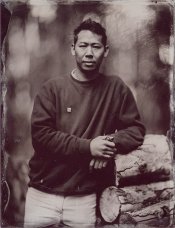I'm a little confused here; aren't the formulas with ether and alcohol assuming that you're making your own collodion?
What do you do if you already have prepared collodion, such as that from Mavidon?
Some formulae assume one is making collodion, but most modern references give an assay that works out to the period recipes without the danger or hassle of making it yourself. The modern formulae require additional solvent and salts (e.g., ammonium iodide) to be added to the stock collodion to form a working-strength collodion. That solvent can be either 190 proof ethanol or denatured alcohol or ether.
As Robert has indicated, varying solvents may affect the tenderness of the collodion as well as the viscosity. Another thing to watch is the water content of the solvent. That's why 190 proof ethanol must be used instead of a lower proof. Denatured alcohol has a similar water content. OTOH, if you used absolute alcohol you would probably have to add a tiny bit of water. Some salts (e.g., potassium bromide) must be dissolved in a small amount of water and this affects the collodion formula as well. Some salts (e.g., cadmium salts) affect the adherence of the collodion to the substrate. All this has an effect on how the collodion clears, flows, etc. A good manual like John Coffer's (or Towler's classic manual
The Silver Sunbeam) addresses all this stuff and is a wise investment.
Attached is an ambrotype made without adding additional ether to the collodion and substituting Everclear 190. The plate emulsion was also compounded as an experiment using sodium bromide and sodium iodide salts and this, perhaps in combination with the high alcohol content has caused the collodion film to dry rapidly before silver sensitization and start to form the white defects at top right.
I haven't had any problems with tenderness of the collodion film unless I'm using a cadmium formula. But, I also haven't used the ether-poor collodion very much to say how the substitution of ethanol affects the results.
It has taken awhile for me to write this response and others have addressed a few of the same points in the meantime. So, sorry from the Department of Redundancy Department.







 .
.
